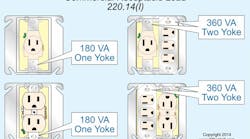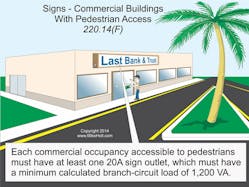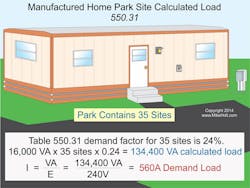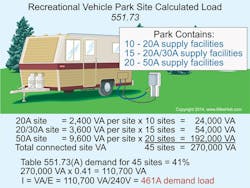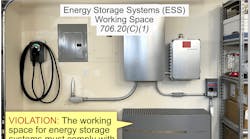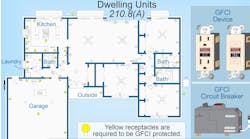The NEC contains detailed requirements for calculating service and feeder loads in many types of occupancies. Although most of these requirements are found in Art. 220, other rules affecting service and feeder loads are scattered throughout the NEC. And that’s the case with commercial occupancies.
Load calculations for commercial occupancies is an important and challenging subject, because there are many different types of commercial buildings and installations — and some have unique rules for calculating service and feeder loads.
Commercial occupancies include many different types of businesses and uses, such as banks, stores, restaurants, and office buildings. Some locations, like marinas and mobile home parks, have their own special requirements. Table 220.3 features a list of additional calculation references to help you locate some of these special requirements.
Lighting demand factors for occupancies
NEC Table 220.12 requires a minimum load per square foot for general lighting, depending on the type of occupancy. For the guest rooms of hotels and motels, hospitals, and storage warehouses, you can apply the demand factors of Table 220.42 to the general lighting load.
Related
There’s usually a diversity of usage in the occupancies that receive demand factors from Table 220.42. By diversity of usage, we mean not all of the lighting is in use continuously. The variations in usage are reflected in sizing the electrical service, but to what extent depends upon the type of occupancy.
Hospitals
You can reduce the general lighting unit load of 2VA per sq ft [Table 220.12] for hospitals, using the Table 220.42 demand factors.
- First 50,000VA at 40% demand factor.
- Remainder VA at 20% demand factor.
Let’s run through an example problem to clarify these points.
What’s the general lighting load for a 100,000-sq-ft hospital after demand factors are applied?
As per Table 220.12, the total general lighting load is: 100,000 sq ft × 2VA = 200,000VA. Now, apply the demand factors as noted in Table 220.42.
- First 50,000VA at 40% = 50,000VA × 0.40 = 20,000VA
- Remainder VA at 20% = 150,000VA × 0.20 = 30,000VA
Therefore, the total demand load = 50,000VA
Hotel or motel guest rooms
You can reduce the general lighting unit load of 2VA per sq ft [Table 220.12] for the guest rooms of hotels and motels, using the demand factors in Table 220.42. These are units without permanent provisions for cooking. Units with permanent cooking provisions are multifamily dwellings, rather than hotels or motels.
Demand factors:
- First 20,000VA at 50% demand factor
- Next 80,000VA at 40% demand factor
- Remainder VA at 30% demand factor
Warehouses
You can reduce the general lighting unit load of ¼ VA per sq ft [Table 220.12] for warehouses, using the demand factors in Table 220.42.
Demand factors:
- First 12,500VA at 100% demand factor
- Remainder VA at 50% demand factor
Keep in mind that the demand factors of Table 220.42 will not apply to service or feeder loads that supply areas of hospitals, hotels, and motels where the entire lighting is likely to be used at one time, such as operating rooms, ballrooms, dining rooms, and similar areas. Calculate these types of areas separately at 100% demand factor.
Other occupancies
For commercial occupancies other than guest rooms (of motels and hotels), hospitals, and warehouses, use a 100% demand factor in your load calculations.
The lighting loads in Table 220.12 are minimum requirements. If the actual lighting load is known and it’s larger than the Table 220.12 value, use the actual load.
Specific applications
The NEC has load calculation requirements for specific types of applications. For example:
- Each commercial occupancy that’s accessible to pedestrians must have at least one 20A branch circuit for a sign [600.5(A)]. The load for the required exterior sign or outline lighting must be at least 1,200VA. If the specific sign or outline load is known to be larger, then the actual load must be used [220.14(F)] (Fig. 1).
- The feeder/service demand load for each linear foot of show-window lighting must be calculated at 200VA per ft [220.14(G)]. Treat show-window lighting as a continuous load. See Example D3 in Annex D for an example calculation.
One application with many variations is the receptacle:
- Each 5 ft, or fraction thereof, of a multioutlet receptacle assembly is considered to be 180VA for feeder/service calculations if it’s unlikely that appliances will be used simultaneously [220.14(H)]. When a multioutlet receptacle assembly is expected to have appliances used simultaneously, each foot or fraction of a foot must be considered as 180VA for feeder/service calculations (Fig. 2).
- The load for a general-use receptacle outlet in a non-dwelling occupancy is 180VA per yoke [220.14(I)]. The maximum number of receptacle outlets permitted on a commercial or industrial circuit depends on the circuit rating. To calculate the number of receptacles per circuit, divide the VA rating of the circuit by 180VA for each receptacle yoke. Note that a duplex receptacle is two receptacles on the same yoke [100]. For this calculation, a single receptacle or a duplex receptacle each count as 180VA (Fig. 3).
- In other than dwelling units, receptacle loads computed at not less than 180VA per outlet yoke 220.14(I), and fixed multioutlet assemblies computed per 220.14(H), can be added to the lighting loads and made subject to the Table 220.42 demand factors for those occupancies in Table 220.42.
- For banks or office buildings, 1VA for each square foot of the building is used for the receptacle load if the actual number of receptacles is unknown [220.14(K)(2)]. If the receptacle count is known, apply the demand factors of Table 220.44 to the total of 180VA per receptacle yoke, and compare the results to the 1VA per sq ft figure, then use the larger of the two.
Manufactured home parks
When sizing the service demand load for a mobile/manufactured home park, apply the demand factors of Table 550.31 to the larger of:
- 6,000VA for each mobile/manufactured home lot, or
- The demand load for each mobile/manufactured home site per Sec. 550.18.
The NEC allows you to size service and feeder conductors to an individual mobile home using Sec. 310.15(B)(7) [550.33(B)].
Let’s run through an example problem to clarify these points.
What’s the demand load for a mobile/manufactured home park that has facilities for 35 sites? The system is 120/240V, single-phase (Fig. 4).
A manufactured home park’s electrical wiring system must be calculated at 120/240V based on the larger of the following [550.31]:
- 16,000VA for each manufactured home lot.
- The load calculated with Sec. 550.18 for the largest typical mobile home that each lot will accept.
The feeder or service load can be calculated using the demand factor percentages in Table 550.31. Since no calculated load per Sec. 550.18 is given, we’ll just use 16,000VA per site in our calculations [550.31(1)].
Demand load = VA × sites × demand factor
As per Table 550.31, 35 sites = 0.24 demand factor
Demand load = 16,000VA × 35 sites × 0.24 = 134,400VA
I = VA ÷ E
I = 134,000VA ÷ 240V
I = 560A demand load
Parallel two conductors per phase: 560A ÷ 2 raceways = 280A
A 300kcmil conductor is rated 285A at 75°C, as per Table 310.15(B)(16). This is large enough for the demand load.
You can use 600A overcurrent protection; Sec. 240.4(B) allows you to round up to the next standard size overcurrent protection not exceeding 800A. The neutral must be large enough to serve the neutral load [220.61], but the minimum neutral size when paralleling conductors is 1/0 AWG [250.24(C)(2) and 310.10(H)].
Recreational vehicle parks
Recreational vehicle (RV) parks are typically equipped with several different sizes of receptacles. Each size of receptacle must be present based on a minimum percentage requirement provided in Sec. 551.71. You can exclude dedicated tent sites when calculating these percentages.
Calculate RV parks using the demand factors of Table 551.73(A). The total demand load is based on the VA per site values listed in Sec. 551.73(A):
- 9,600VA for each site with 50A, 120/240V supply facilities.
- 3,600VA for each site with 20A and 30A, 120V supply facilities.
- 2,400VA for each site with 20A, 120V supply facilities.
Once again, let’s run through an example problem to clarify these points.
What’s the demand load for a recreational vehicle park that has ten 20A supply facilities, fifteen 20A and 30A supply facilities, and twenty 30A and 50A supply facilities? The system is 120/240V, single-phase (Fig. 5).
The service for the recreational vehicle park is sized using the demand factors in Table 551.73(A).
- Ten 20A sites (2,400VA × 10 sites) = 24,000VA
- Fifteen 20A and 30A sites (3,600VA × 15 sites) = 54,000VA
- Twenty 50A sites (9,600VA × 20 sites) = 192,000VA
Therefore, the total connected load for the 45 sites = 270,000VA
Demand load = 270,000VA × 0.41 [Table 551.73(A) for over 36 sites]
= 110,700VA
I = VA ÷ E
I = 110,700VA ÷ 240V
I = 461A demand load
Parallel two conductors per phase: 461A ÷ 2 raceways = 231A
A 250kcmil conductor is rated 255A at 75°C, as per Table 310.15(B)(16).
The neutral must be large enough to serve the neutral load [220.61], but the minimum neutral size when paralleling conductors is 1/0 AWG [250.24(C)(2) and 310.10(H)].
Demand factor caution
Be careful when applying demand factors to commercial installations. For example, the demand factors for dryers in Table 220.54 are for dwelling units only. You can’t use them for laundromats or similar locations. There are different rules and, in some cases, different demand factors for commercial occupancies. In Part 2, we will examine more applications that have their own demand factors and rules.
Holt is the owner of Mike Holt Enterprises, Inc. in Leesburg, Fla. He can be reached at www.mikeholt.com.
